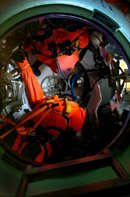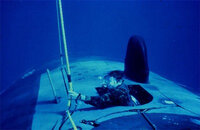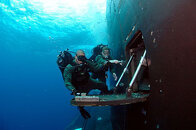The Skandi Arctic is a beast!....
That was my thought, though I have not been aboard. She "looks" like she brings a higher day rate to the mix without a significant increase in sea-state bell ops. Do you have any idea how well she is competing with other North Sea DSVs?
The sat system has a lot of wiz-bang automation, but it is hard to tell if there is much reduction operator head-count. System maintenance and troubleshooting looks like a nightmare.
I was heavily involved with the Seaway Swan in the late 1970s. She had two bells and an 18-man sat system, but two-man lockouts were rare except on hyperbaric welding jobs.
The Swan was an 8-leg semisubmersible with a 200 Ton crane and 100 Meter boom. She could operate in much higher sea states than mono-hulls because each bell had a moonpool/launch tube from above the main deck to the bottom of the port-side pontoon -- which was at 75'/23 Meters when ballasted-down for diving operations. The bells had a cursor system that went to the bottom of the pontoon. Bells could launch in Sea State 7, maybe even 8, in open water. My brother did some lockouts in Sea State 6 and could hardly notice the bell moving.
Like the Uncle John, another semisubmersible DSV, she just proved to be too expensive. I understand she was converted to a drilling platform after she spent too much time tied up to the quay.
Question: How did they get away with a 24-man system and only an 18-man hyperbaric lifeboat?






